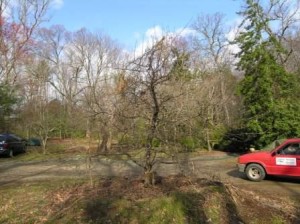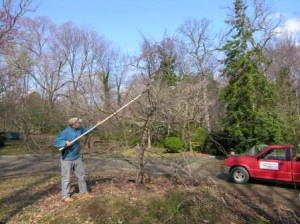Fruit trees can be pruned at anytime of the year. However, to maximize the development of an eatable fruit it is best to prune before the flower buds break in the spring. Additional pruning and fruit thinning may become necessary during fruit bearing months to prevent limb breakage due to over burdened branches. A well pruned tree having a stout trunk and branch structure can support a bumper crop of fruit without external support or props.Gather together the necessary tools and size up the job at hand. You may need these tools : CHAIN SAW; POLE SAW; POLE PRUNER; LONG HANDLE LOPPERS; HAND PRUNERS; HAND SAW; LADDER
Faced with a tree in need of a heavy pruning, first picture the finished work in your mind. An apple tree for example requires a strait central trunk with one, two, three, or more levels like a wedding cake or chandelier. Remove congestive branches starting with the big cuts first.
Second, establish the number of levels (apple) or the shape the tree will have. In this example the apple tree has three levels or tiers. Next establish a separation of branches from the ground to the first tier, a separation from the first tier and the second tier, and a separation between the second tier and the final third tier or top level.
Finally prune all remaining branches so there are no deadwood, broken or diseased limbs, crossing and rubbing stems, and thin out any remaining congested areas. If it appears you have taken to much out ,don’t worry it will all grow back in time, especially if you follow my instructions on root zone maintenance. Contact Habitat Services for a consultation. Call now (434)-296-3327 or email shbs@habitatservices.net.

